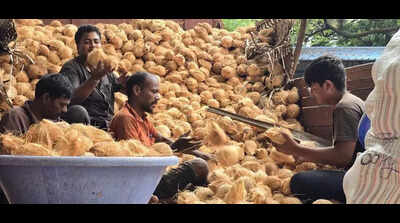- News
- City News
- bengaluru News
- Coconut prices go up, leaving bitter aftertaste for Bengalureans
Trending
Coconut prices go up, leaving bitter aftertaste for Bengalureans
Bengaluru: If you love your dosa or idli with chutney but feel the latter tastes less ‘coconutty' these days, you're not alone. From chutneys and curries to refreshing summer coolers, the humble coconut has long been a staple in kitchens. However, this summer, your favourite nutty, creamy ingredient is pinching pockets and leaving a bitter aftertaste — not just in consumers, but also restaurants and caterers. A month ago, a coconut cost around Rs 25 on average; now it costs between Rs 65 and Rs 80.
The city gets its coconuts from Mandya, Hassan, Tumakuru, and a few parts of Andhra Pradesh, Kerala, and Tamil Nadu. There are two types of coconuts in the market — white Badami and black — with the former used most, especially in cooking. According to dealers, the supply of white Badami has taken a hit because of last year's poor rainfall, leading to a drastic price spike.
Venkaigowda, a coconut dealer from Vijayanagar who has been in the business for 20 years, said, "Earlier, coconut prices started as low as Rs 20 (per unit), but the shortage and summer demand has pushed up prices to over Rs 60. There's a chance the rates may dip in the next 20 days to a month, though nothing is certain."
Rajshekar, a coconut dealer from APMC yard, Yeshwantpur, said: "Last year's low rainfall caused many trees to dry up, which is one of the major reasons for the shortage. We mostly get our coconuts from Mandya and the three neighbouring states, but unfortunately, all these states are experiencing supply shortage. Additionally, the wedding season has drastically driven up prices."
GK Shetty, president of Karnataka State Hotel Association, said: "Most restaurants, to manage the demand and rising costs, have reduced the amount of coconut used in their dishes. The use of coconut has gone down by at least 40%. With prices of multiple commodities going up, it's becoming hard for restaurants to cope and bear the brunt. Even small eateries that rely heavily on coconut to maintain quality are struggling."
"Because of the rising prices, we've had to reduce the quantity of coconuts used in our catering services. For events with 2,000 to 3,000 people, we used to use 400-500 coconuts just for chutney, with extra demand sometimes pushing it higher. Now, we've cut that down to 350, depending on customer requirements," said Raghavendra Rao of RR Caterers, Rajarajeshwari Nagar.
However, a few big restaurants have decided to bear the costs to continue their business and keep up with the demand for coconut dishes. Sagar K, manager of Salt Mango Tree, Indiranagar, said, "On average, we use at least 100kg of coconuts in our dishes for 2-3 days. During summer, we usually see the demand for coconut dishes increase because of the taste and coolness it gives. For this summer, we've seen a 10% increase in demand. Prices have gone up but we've decided to bear it for the sake of our business."
End of Article
Follow Us On Social Media









